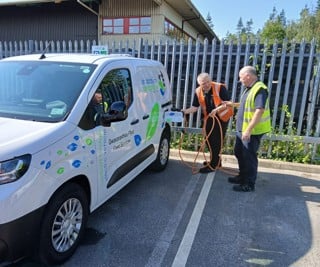
The take-up of electric vehicles (EVs) has been rather slower than predicted a few years ago.
While some have played down the ongoing role of pure EVs, alongside the emerging plug-in hybrids, hybrids, hydrogen fuel cells and more efficient petrol and diesel cars, others believe they will play a crucial role in the so-called ‘smart cities’ of the future. Colin Herron, managing director of Gateshead-based Zero Carbon Futures, describes 2015 as a tipping point for EVs.
Zero Carbon Futures was established in 2011 as a not-for-profit subsidiary of Gateshead College, and has been working to establish how emerging low-carbon technologies will be integrated into daily life. Herron believes ‘smart cities’ and ‘future cities’ will be key in creating the types of environments where EVs will thrive.
“We can have a smart city that isn’t a future city, but not a future city that isn’t smart,” he told delegates at an electromobility seminar organised by Nissan.
“A smart city is more efficient, sustainable, uses integrated technology.”
Essentially, according to Herron, all future cities will be smart cities, and a strong infrastructure for charging vehicles underpins growth in take-up. He believes the current level of charging points is coming under strain in city centres with increasing uptake of plug-in vehicles, suggesting more rapid charge points are needed. This will, in turn, make EVs more feasible for more customers, increasing their usability during the day with improved access to quick recharging.
Having a reliable infrastructure with adequate capacity is crucial to increasing adoption. “We need community ‘pull’ and not technology ‘push’,” said Herron.
Town and cities that are seeking to increase EV use must also ensure to future proof themselves.
“In future cities, all technologies must be linked and talking to each other,” he said. “Healthcare must be integrated and age friendly; utilities must include energy storage as well as generation; mobility must be zero emissions and accommodate autonomous technology; business must be energy-efficient and carbon neutral.
“It’s not just about big data and ‘the internet of things’. It’s much more than that. Smart cities must build in future technology now. Cities must ask what their strengths are, what they are good at and what are they not good at. For example, bicycles work well in Amsterdam but would fail in Venice.”
As EV take-up increases, there could be a ready market for used batteries. Herron says that energy storage requirements could be met by EV batteries undergoing a ‘second life’. Some organisations have already begun deploying used EV battery cells as a way of storing electricity.
A battery cell will typically recharge to around 80% of capacity after four years of use. While that might make them less effective for EVs, they can help organisations reduce energy costs by being charged by solar power.
Indeed, they could have a ‘second life’ of an additional 16 years, as lithium-ion batteries can deliver around 80% of capacity for many years afterwards, in that time helping cut utility bills and use ‘greener’ energy.
While EVs are now vying for attention alongside plug-in hybrids and new hydrogen fuel cell vehicles, Herron believes more work is needed to investigate the potential and the role they can play in ‘future city’ development bringing together the three strands of grid, vehicle and community.
“Cities must be made EV friendly to the point where people will then ask, ‘Why not EV?’” said Herron.

















Login to comment
Comments
No comments have been made yet.